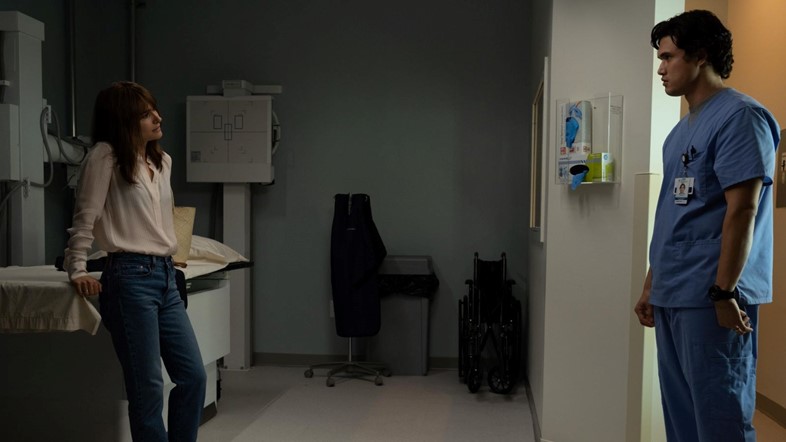Carol director Todd Haynes delves into his tale of artifice and performance – loosely inspired by Mary Kay Letourneau – and the ”astonishingly nuanced” performances of Julianne Moore and Natalie Portman
There is an unforgettable scene in the first few minutes of Todd Haynes’ May December, one you can imagine being clipped to hell and back on Twitter to a reverent online chorus of “she’s mothering” – but it is bone-chillingly prescient. Julianne Moore, sporting a blonde wig and breathy lisp as Gracie Atherton-Yoo, a housewife in Savannah, Georgia, opens the fridge. Gazing into its depths, she half-gasps, half-mourns: “I don’t think we have enough hot dogs.” Then we hear a ‘blood-curdling’, horror-movie scream. “And it’s just a little kid who lost her balloon,” says Haynes, retracing the beats of this introductory moment. “That line I didn’t necessarily find comedic. I found it a really insightful clue.”
For Haynes, May December is the latest gem in a storied career that has always been concerned with identity as mouldable surface, from landmark works in the new queer cinema of the 90s like Poison (1991) to glam-rock opera Velvet Goldmine (1998) and lesbian period romance Carol (2016). A masterfully choreographed dance of campy theatrics and disquieting impulses, May December is as intrigued by artifice and performance as it is by the deep entanglements of perversion.
It’s also a movie about the making of a movie. Natalie Portman stars as actress Elizabeth Berry, who has arrived in Savannah to meet and study Moore’s Gracie, whom she is set to play in a film. In an expository scene told in closeups of old tabloids, we learn why: splashed across the pages are photos of a decades-younger Gracie, looking doe-eyed into the camera and wearing inmate orange.
At the core of May December’s matryoshka doll is the real-life woman that Gracie is loosely based on: Mary Kay Letourneau, a schoolteacher who went to prison for seven and a half years after having sex with her 12-year-old student, Vili Fualaau. She was 34, and gave birth to Fualaau’s child while awaiting sentencing; Letourneau and Fualaau later married.

In May December, the boy (now man) is called Joe Yoo, and is played by an incredible, inward-collapsing Charles Melton. Elizabeth’s slow invasion into his and Gracie’s life destabilises the married couple’s domestic, nuclear-family peace – her rapturous voyeurism unburying the past, exposing what the entire town seems eager to forget. In one stunning scene, Elizabeth pays a visit to the fateful site of Joe and Gracie’s tryst: a pet-store supply closet, bathed in blue aquarium light. She asks to see it, alone, a telling, tremulous smile plays at her lips. Lowering herself on to the doorstep, she closes her eyes, and begins to act out the sex scene: gasping, shivering at the imagined touch of a boy in seventh grade.
May December is a film that delights in its own layered reflexivities, in the masochistic thrills of coaxing our pleasure from the same things it punishes its characters for. “I think the film enjoys toying with received ideas about the narrative process, [and] the privilege of creators of representation, who are there to ostensibly tell truths,” says Haynes. “Their truths are valorised in ways that other people’s aren’t, simply because they have the means and the resources to pursue them.” He is talking about Elizabeth, but of course, May December is itself implicated: its makers, its consumers.
Where does that leave us, as people experiencing the cinematic pleasures of this film, unable to tear our eyes from the spectacle of perversity – perhaps allowing ourselves to do so because it is draped with several layers of artifice? “We’re also complicit,” says Haynes. “The film allows you those dual positions to occupy. We get to be amused by those hierarchies” – between subject and object, narrator and narrated – “even though we live them at the same time.”

Portman sent Haynes the screenplay for May December, written by Samy Burch, during the height of the pandemic; the director was immediately enthralled. “It knew how to negotiate a kind of distance,” says Haynes about his response to encountering this chameleonic, swirling thing on the page, what it withheld from the reader. “At first I thought, ‘Is this just a young writer who doesn’t know that the conventions of scriptwriting are there to tell you exactly what they’re doing at every moment?’” He laughs. “And then I was like, ‘Oh, she’s several steps ahead of these conventions. She’s giving the reader that rare negotiating space.’”
Translating this on to the screen – and positioning the audience in an “active mode of interpretation” – May December is edited with scalpel precision. The eerie stillness of the frame is routinely ruptured by a cut, or the swelling strains of Michel Legrand’s immense score for The Go-Between, which Haynes rediscovered while researching references for his film. “It knocked my socks off,” says the director. “Even before the film begins, it’s like, ‘fasten your seatbelt, audience’. It felt like the best example of what the score could be in this film. It had to have very bold frames around it, [to] let you know you were being asked to interpret and make you think about every square inch of the frame.”
Though originally meant to take place in Maine, May December was shot in Savannah due to scheduling necessities – including the need for the film to take place in the titular month of May, against the backdrop of Joe and Gracie’s kids’ imminent graduation from high school. Savannah unexpectedly gifted the film its aesthetic, its specific texture of suburban America. “What we found there was [this] strange environment that we tried to commit our visual language to,” says Haynes. May December is cocooned in gauzy Americana: star-spangled banners, barbecues, a black forest cake with carefully-placed cherries because, as Gracie says, much too innocently, “it really does matter how it looks”. The camera lens’ peculiar fuzziness replicates the claustrophobic thickness of the city’s air. “This locked-in, intense humidity: you feel [it] in the glass windows of the homes there, it seeps into the way we look out the windows, the way you feel when you step out of your air-conditioned car,” the director says. “It curtails your sense of mobility and freedom.”

That oppressiveness bleeds into something perhaps even more ubiquitous, even more difficult to pin down. Politically and spatially, May December inhabits an architecture of whiteness: the violence of how it establishes itself as normalcy, so omnipresent it becomes almost unremarkable. Joe’s ethnicity is mentioned just once, at the dinner table, by Gracie; it is the film’s only salient acknowledgement of race. “Joe’s otherness as a Korean-American is just one more aspect that makes the choice to seduce this young boy all the more fraught and transgressive,” says Haynes. “But the most shocking thing about the film is the way everybody is there to deny these differences, and [assert] normalcy, the continuity of the family.”
May December blossoms – beautiful, fragile yet obscene, like a flower – in the rich performances of Portman, Moore and Melton, all of whom embody the film’s exhilarating commitment to meta-performance, straddling that line between the permissible and the impermissible, the real and the pretend, with aplomb. “I find the performances astonishingly nuanced, subtle and intricate – the components of which I am never micromanaging as a director,” says Haynes. Precisely crafted as May-December is, there are some things that are more to do with magic than control. “In the end, the details and the membranes, the vicissitudes of what actually happens on screen, is happening between living artists, in real time. [What] I enjoy when I watch the movie over again are things that were happening between these actors that can barely find articulation.” Still talking about his actors, Haynes lands on the perfect way to capture the seductive ambivalence of this film. “If you articulated it too much, it would destroy it.”
May December is out in UK cinemas now.
